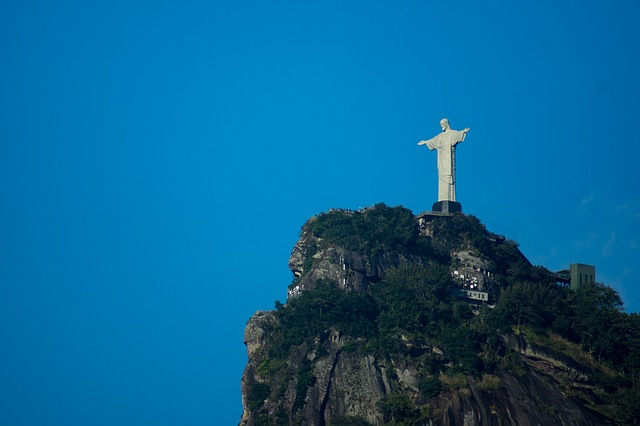Rio de Janeiro city guide
Founded in 1565 on the South Atlantic coast by the Portuguese as a fortification against French privateers Rio de Janeiro is the second largest city in Brazil. The Christ The Redeemer statue, Sugarloaf Mountain , Copacabana and Ipanema beaches and Maracana stadium are the famous landmarks of Rio de Janeiro. Most famous attraction around the world is the " Carnaval " Carnival celebration.
Best time to visit is the summer months for Brazil ( December to March , February is the hottest ) and the spring months ( September to November ).
Popular places


Rio Carnival
Attractions :
- Southern Zone
- Christ the Redeemer Statue , built from 1922 to 1931 and covered in a mosaic of soapstone stands 30 meters high,is overlooking the city on top of Rio de Janeiro's Corcovado Mountain 710 m
- Sugar Loaf Mountain : The summit of Rio's unique 1,299ft high (396m) belvedere. You can go to the top by the cable cars.
- Pedra da Gavea: Watch the panoramic city view.
- Hanggliding and Paragliding
- Panoramic helicopter rides
- Rodrigo de Freitas Lagoon
- Central Zone
- Carnaval ( Carnival ) celebration: Parade of the Samba schools which dure 2 weeks in Sambadrome in February.
- Samba City
- Santa Teresa Historic Tramway
- Northern Zone
- Maracana Stadium: One of the most famous satdiŘms of the world. 100 000 seatings.
- Samba schools : Mangueira,
Salgueiro,
Unidos de Vila Isabel,
Unidos da Tijuca
- Western Zone
- Rio Water Planet: Very large amusement park

- Pedra do Telegrafo: Watch the view from themountain.
Beaches :
- Southern Zone
- Copacabana Beach : Worldwide famous beach with multiple sections
- Ipanema Beach: Another popular beache with soccer fields, workout stations and volleyball courts.
- Urca Beach
- Vermelha
- Leme
- Arpoador
- Leblon
- Sao Conrado
- Eastern Zone
- Barra da Tijuca
- Recreio
- Barra
- Northern Zone
- - Ramos
Museums :
- Central zone
- National Museum of Fine Arts ( The Museu Nacional de Belas Artes ) :inaugurated in 1938 20,000 pieces, among paintings, sculptures, drawings and prints, of Brazilian and international artists

- The National Historical Museum of Brazil (Portuguese: Museu Historico Nacional), was created in 1922, and possesses over 287,000 items, among of which the largest numismatic collection of Latin America.

- Museum of Modern Art (Museu de Arte Moderna do Rio de Janeiro ):
The National Museum of Brazil built in 1818. The Museum shelters one of the largest exhibits of the Americas, consisting of animals, insects, minerals, aboriginal collections of utensils, Egyptians mummies and South American archaeological artifacts, meteorites, fossils and many other findings.

- National History Museum ( Museu Histˇrico Nacional ):
1762 objects related to the history of Brazil from colonial to imperial times

- Museu Chacara do Ceu : Exhibits art collections : Rare books, furniture and decorative pieces, distributed through a three-story house.

- Casa do Pontal is the largest museum of Brazilian folk art, displaying around 5,000 sculptures by more than 200 artists from every region of the country.

- Casa do Pontal is the largest museum of Brazilian folk art, displaying around 5,000 sculptures by more than 200 artists from every region of the country.
- Naval and Oceanographic Museum (Museu Naval e Oceanografico ) :
- Tram Museum ( Museu do Bonde ) : Photos and models realred the tram in Rio.
- Southern Zone
- Indian Museum (Museu do Indio): decorate yourself as native warriors.

- Museum of the Universe and Space (Planetarium Espaco Museu do Universo ) to discover the physics and astronomy.

- Museu Carmen Miranda : Memorabilia from the famed singer's career .

- Museum of the Republic ( Museu da Republica ):
Ancient palace with beautiful garden built in the miiddle of the 19th century.It contains collection of artwork related to the Republic years.

- Army History Museum of Copacabana Fort ( Museu Historico do Exercito e Forte de Copacabana):
The goal of the museum is to disseminate the values, traditions and historical memory of the Brazilian Army.

- Indian Museum (Museu do Indio):
History of Native Brazilians

- Museu do Folclore Edison Carneiro : Folk art museum, art from all over the country: ceramics, musical instruments, toys, religious tools, and photographs among others.
- Instituto Moreira Salles :
Exhibitions of the art photos
- Northern Zone
- Museum of the First Reign ( Museu do Primeiro Reinado ) A museum about the reign of Emperor Pedro I during the 19th century .

Lage Park
Parks :
- Northern zone
- Rio de Janeiro Zoo Animals from all over the world: Lions, alligator, bears, flamingos ...

- Tijuca National Park (Parque Nacional da Tijuca), The largest city-surrounded urban forest and the second largest urban forest in the world. Bird watching, climbing, skateboard, waterfall bath

- Central zone
- Passeio Publico An 18th-century public garden
- Southern zone
- Botanical Garden (Jardim Botanico), founded in 1808, contains 6,500 species of flora and 140 species of birds.

- Flamengo Park (Parque do Flamengo) Located between Flamengo and Gloria. 1 million square meters.

- Parque Enrique LagePublic park in the subtropical forest. The land was formerly the residence of industrialist Enrique Lage and his wife,
- Passeio Publico An 18th-century public garden
Airport:
Galeao-Antonio Carlos Jobim International Airport (Galeao International Airport) : It is located 20 km from downtown Rio.
Jacarepagua-Roberto Marinho Airport: located 30 km from the city center.
Santos Dumont Airport
Hotels & Restaurants:
Use our Place Explorer page to find the Hotels , restaurants and car rental services.
Rio de Janeiro Map
 Rio Carnival
Rio Carnival Lapa Viaduct
Lapa Viaduct  Lage Park
Lage Park